What The Bisexual Pride Flag Colors Mean For The LGBT+ Community
What does a group have to do for some representation around here?
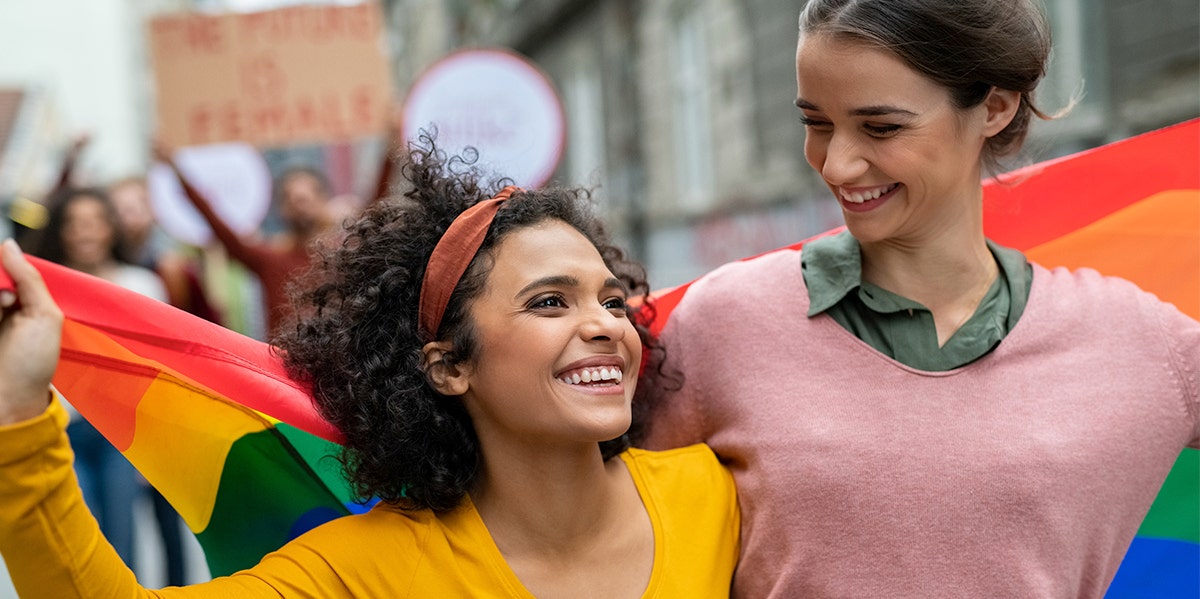 Rido / shutterstock
Rido / shutterstock Looks like we won’t be celebrating bisexual pride with a bisexual flag emoji any time soon.
LGBTQ inclusivity in emoji platforms has been a subject of debate for a long time, and it appears like that journey is far from over since the bisexual pride flag will not be included in 2021’s emoji release.
Before we get into the reasons why, let's take a look at the bisexual pride flag and what it stands for.
What is the history of the bisexual pride flag?
The flag itself was created and designed by Michael Page in December of 1998. Page was reportedly aiming to increase the visibility of bisexuals, both among society as a whole and within the LGBT community.
He wanted something bisexual people could hoist up into the air to be seen.
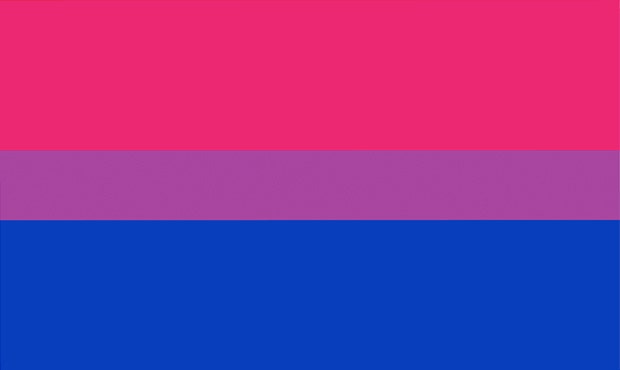 Image: Michael Page / Wikimedia Commons
Image: Michael Page / Wikimedia Commons
What do the colors in the bisexual pride flag mean?
Regarding why he chose the color scheme for the flag, Page said, “In designing the Bi Pride Flag, I selected the colors and overlap pattern of the ‘bi angles’ symbol.”
The colors in the flag each represent something: Pink represents the female gender, purple represents sexual attraction to both sexes, and blue represents the male gender.
What is the bisexual symbol?
The original bisexual symbol is that of the “bi angles.” The symbol consists of two upside-down overlapping triangles. One is blue the other is pink, and the small part where the two overlaps is purple.
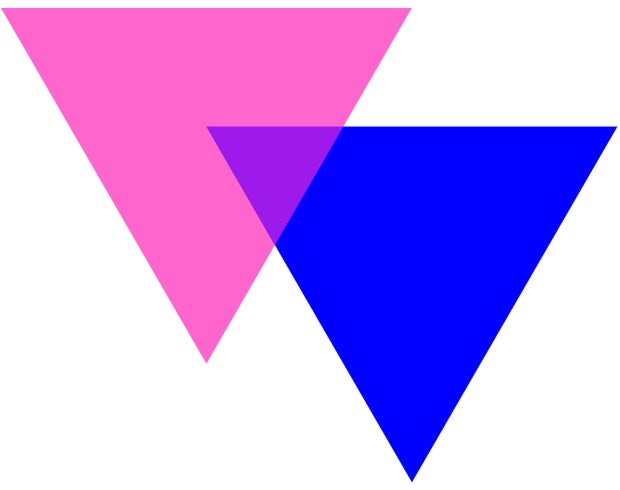 Image: Wikimedia Commons
Image: Wikimedia Commons
This was used to represent the bisexual community until its creation of their unqiue pride flag.
There are a few other symbols used, like the male and female gender symbols tied together by an infinity sign, that some people put on the flag as well.
What do the colors in the LGBT flag stand for?
While there is a flag for bisexual pride that represents male and female birth genders, and their attraction to both sexes, the LGBT flag includes eight colors total.
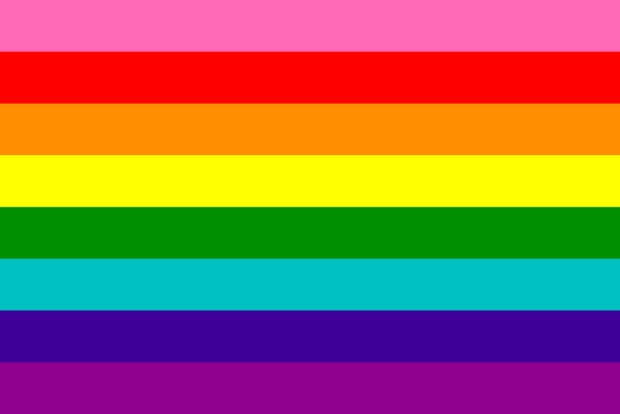 Image: Gilbert Baker / Wikimedia Commons
Image: Gilbert Baker / Wikimedia Commons
The gay pride flag has been around since 1978, and its colors represent:
1. Hot pink for sex
2. Red for life
3. Orange for healing
4. Yellow for sunlight
5. Green for nature
6. Turquoise for art
7. Indigo for harmony
8. Violet for spirit
The pansexual community also has a flag that consists of three horizontal stripes of pink, yellow, and blue.
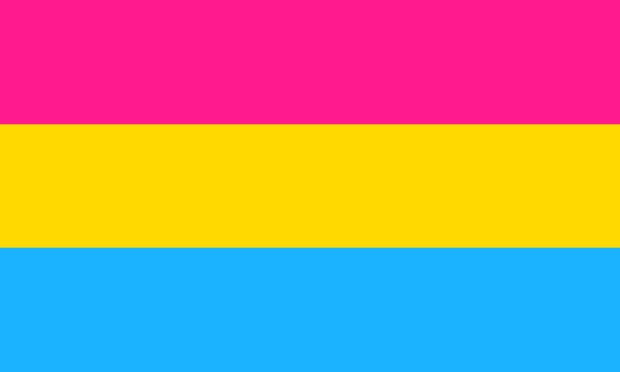 Image: Wikimedia Commons
Image: Wikimedia Commons
In the flag for pansexuals, blue represents those who identify as male, pink represents those who identify as female, and yellow represents those who identify as both genders, neither gender, or a third gender; the yellow also represents "non-binary attraction between the male and female genders."
So, why will there be no bisexual pride flag emoji?
Unicode Consortium turned the Bi Pride Flag down.
Unicode Consortium, the organization that governs internationally recognized symbols, turned down a proposal submitted by tech engineer and bisexual activist Tanner Marino early in 2020. Marino subsequently launched a Change.org petition in November 2020 to encourage Unicode to change their decision.
The petition has amassed over 16,000 signatures so far, but there is still no response from Unicode. In fact, the organization has paused emoji proposals until April 2021, which could greatly impact the future of LGBTQ emoji requests.
We’ve come a long way from the days of only heterosexual couple emojis and no gender-neutral emojis. We have a pride flag emoji. A long but successful battle to have trans pride flag emoji was won this year. So why then was the bisexual pride flag emoji rejected?
Emoji proposals have a lot of hoops to jump through.
The journey of an emoji from idea to something you can use in your texts is a lengthy one. Unicode takes submissions from the general public which are reviewed by a handful of individuals on the Emoji Subcommittee in the early months of each year.
Anyone can submit an idea but there are strict criteria for each proposal. Vendors including Google, Apple, Microsoft, Twitter, and Facebook don’t have their say until proposals are approved by Unicode.
So what makes a good proposal? Unfortunately for the LGBTQ community, representation and political correctness is not a huge concern of Unicode. Nor do they pay much attention to petitions.
The Unicode website states: “The submission and selection process isn't affected by simple suggestions, nor by petitions, nor by letters/tweets from celebrities/government officials.”
Statistical evidence is definitely favored by the organization. According to statistics compiled by Unicode, flags are among the least used emojis which may explain Unicode’s unwillingness to concentrate their efforts on this category.
What Unicode does recommend for approval is making group submissions and offering compelling evidence. But considering petitioners for the emoji has made it clear that a lack of bisexual representation contributes to the mental health problems of this group, it’s possible that Unicode and bisexual activists have a different definition of what “compelling evidence” means.
The battle for a trans pride flag emoji shows what it takes to get LGBTQ representation in emojis.
Of course, if you followed the movement to get a trans pride flag approved by Unicode, the story of the bisexual pride flag emoji will sound familiar.
The trans flag took several years of submissions, a team of dedicated activists, and devoted media pressure before it was included in the official 2020 emoji additions.
If you thought this movement might at least open doors for other gender and sexuality representations, think again. Marino has left his Change.org petition open, knowing that the effort to get bisexual representation in emojis could follow the same drawn-out fate.
That said, in the years leading up to the trans flag emoji approval, Unicode managed to approve hundreds of new emojis including a cupcake, an otter, and broccoli. Are there international movements for these emojis? Is anyone relying on these emojis for representation and validation?
The bisexual flag is more than just an emoji.
A pixelated pink, purple and blue flag will not end bi-phobia. It may not stop people from making comments like “They’re just confused,” “She’s just easy,” or “He’s gay, he just hasn’t realized it yet."
But a bisexual pride flag emoji would be a small win for a community that often lacks representation.
On his Change.org petition, Marino includes a quote from Sara, a bisexual woman living under an Islamic Regime where it is illegal for her to publicly demonstrate her sexuality.
She says, “A bisexual flag emoji can spark curiosity: people will see it and wonder why this three colored rectangle exists and what it means. It may even lead to their own self-discovery. I want people to know that my sexuality is valid and I'm not a confused person. I love to flaunt my bisexuality as much as I can and would love to express myself with the flag that I'm so proud to be a part of.”
Emojis are a universally used language. For the bisexual community, this would be an important means of expression and representation that can be used around the globe.
Besides, who is it hurting to validate the identities of the bisexual community?
Alice Kelly is a writer with a passion for social justice issues, news, and trending topics.
